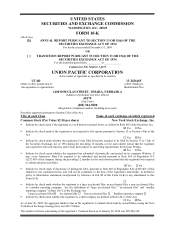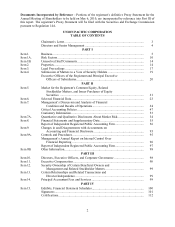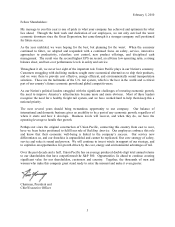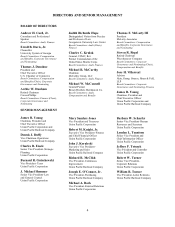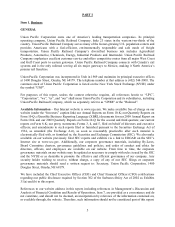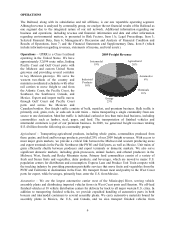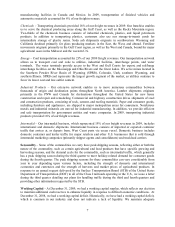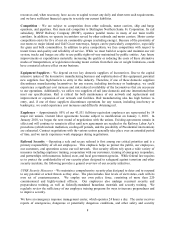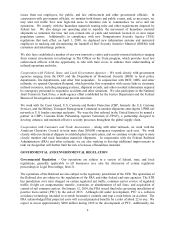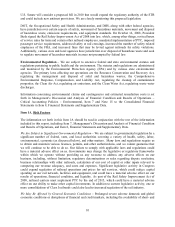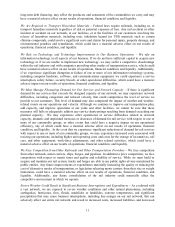Union Pacific 2009 Annual Report Download - page 10
Download and view the complete annual report
Please find page 10 of the 2009 Union Pacific annual report below. You can navigate through the pages in the report by either clicking on the pages listed below, or by using the keyword search tool below to find specific information within the annual report.
10
U.S. Senate will consider a proposed bill in 2010 that would expand the regulatory authority of the STB
and could include new antitrust provisions. We are closely monitoring this proposed legislation.
DOT, the Occupational Safety and Health Administration, and DHS, along with other federal agencies,
have jurisdiction over certain aspects of safety, movement of hazardous materials, movement and disposal
of hazardous waste, emissions requirements, and equipment standards. On October 16, 2008, President
Bush signed the Rail Safety Improvement Act of 2008 into law, which, among other things, revised hours
of service rules for train and certain other railroad employees, mandated implementation of PTC, imposed
passenger service requirements, addressed safety at rail crossings, increased the number of safety related
employees of the FRA, and increased fines that may be levied against railroads for safety violations.
Additionally, various state and local agencies have jurisdiction over disposal of hazardous waste and seek
to regulate movement of hazardous materials in areas not preempted by federal law.
Environmental Regulation – We are subject to extensive federal and state environmental statutes and
regulations pertaining to public health and the environment. The statutes and regulations are administered
and monitored by the Environmental Protection Agency (EPA) and by various state environmental
agencies. The primary laws affecting our operations are the Resource Conservation and Recovery Act,
regulating the management and disposal of solid and hazardous wastes; the Comprehensive
Environmental Response, Compensation, and Liability Act, regulating the cleanup of contaminated
properties; the Clean Air Act, regulating air emissions; and the Clean Water Act, regulating waste water
discharges.
Information concerning environmental claims and contingencies and estimated remediation costs is set
forth in Management’ s Discussion and Analysis of Financial Condition and Results of Operations –
Critical Accounting Policies – Environmental, Item 7 and Note 15 to the Consolidated Financial
Statements in Item 8, Financial Statements and Supplementary Data.
Item 1A. Risk Factors
The information set forth in this Item 1A should be read in conjunction with the rest of the information
included in this report, including Item 7, Management’ s Discussion and Analysis of Financial Condition
and Results of Operations, and Item 8, Financial Statements and Supplementary Data.
We Are Subject to Significant Governmental Regulation – We are subject to governmental regulation by a
significant number of federal, state, and local authorities covering a variety of health, safety, labor,
environmental, economic (as discussed below), and other matters. Many laws and regulations require us
to obtain and maintain various licenses, permits, and other authorizations, and we cannot guarantee that
we will continue to be able to do so. Our failure to comply with applicable laws and regulations could
have a material adverse effect on us. Governments may change the legislative or regulatory frameworks
within which we operate without providing us any recourse to address any adverse effects on our
business, including, without limitation, regulatory determinations or rules regarding dispute resolution,
business relationships with other railroads, calculation of our cost of capital or other inputs relevant to
computing our revenue adequacy, and costs and expenses. Significant legislative activity in Congress
could expand regulation of railroad operations and prices for rail services, which could reduce capital
spending on our rail network, facilities and equipment, and could have a material adverse effect on our
results of operations, financial condition, and liquidity. As part of the Rail Safety Improvement Act of
2008, railroad carriers must implement PTC by the end of 2015, which could have a material adverse
effect on our ability to make other capital investments. In addition to current legislative activity, one or
more consolidations of Class I railroads could also lead to increased regulation of the rail industry.
We May Be Affected by General Economic Conditions – Prolonged severe adverse domestic and global
economic conditions or disruptions of financial and credit markets, including the availability of short- and

